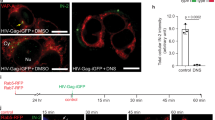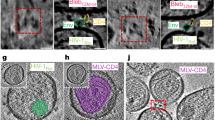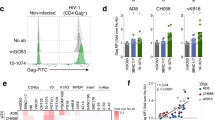Abstract
AIDS is an immunoregulatory disorder characterized by depletion of the CD4+, helper/inducer lymphocyte population1. The causative agent of this disease is the human immunodeficiency virus, HIV2–4, which infects CD4+ cells and leads to cytopathic effects characterized by syncytia formation and cell death5,6. Recent studies have demonstrated that binding of HIV to its cellular receptor CD4 is necessary for viral entry7,8. We find that binding of HIV to CD4 induces rapid and sustained phosphorylation of CD4 which could involve protein kinase C. HIV-induced CD4 phosphorylation can be blocked by antibody against CD4 and monoclonal antibody against the HIV envelope glycoprotein gp120, indicating that a specific interaction between CD4 and gp120 is required for phosphorylation. Electron microscopy shows that a protein kinase C inhibitor does not impair binding of HIV to CD4+ cells, but causes an apparent accumulation of virus particles at the cell surface, at the same time inhibiting viral infectivity. These results indicate a possible role for HIV-induced CD4 phosphorylation in viral entry and identify a potential target for antiviral therapy.
This is a preview of subscription content, access via your institution
Access options
Subscribe to this journal
Receive 51 print issues and online access
$199.00 per year
only $3.90 per issue
Buy this article
- Purchase on Springer Link
- Instant access to full article PDF
Prices may be subject to local taxes which are calculated during checkout
Similar content being viewed by others
References
Fahey, J. L. et al. Am. J. Med. 76, 95–100 (1984).
Barre-Sinoussi, F. et al. Science 220, 868–871 (1983).
Gallo, R. et al. Science 224, 500–503 (1984).
Levy, J. A. et al. Science 225, 840–842 (1984).
Lifson, J. D., Reyes, G. R., McGrath, M. G., Stein, B. S. & Engleman, E. G. Science 232, 1123–1127 (1986).
Lifson, J. D. et al. Nature 323, 725–728 (1986).
Stein, B. S. et al. Cell 49, 659–668 (1987).
Kowalski, M. et al. Science 237, 1351–1355 (1987).
Hoxie, J. A., Matthews, D. M., Callahan, K. J., Cassel, D. L. & Cooper, R. A. J. Immun. 137, 1194–1201 (1986).
Acres, R. B., Conlon, P. J., Mochizuki, D. Y. & Gallis, B. J. biol. Chem. 261, 16210–16214 (1986).
Weyand, C. M., Goronzy, J. & Fathman, C. G. J. Immun. 138, 1351–1354 (1987).
Hidaka, H., Inagaki, M., Kawamoto, S. & Sasaki, Y. Biochemistry 5036–5042 (1984).
McDougal, J. S. et al. J. Immun. 135, 3151–3162 (1985).
McDougal, J. S. et al. Science 231, 382–385 (1986).
Sodroski, J., Goh, W. C., Rosen, C., Campbell, K. & Haseltine, W. A. Nature 322, 470–474 (1986).
Dalgleish, A. G. et al. Nature 312, 763–766 (1984).
Klatzmann, D. et al. Nature 312, 767–768 (1984).
Maddon, P. J. et al. Cell 47, 333–348 (1986).
Sredni, B., Volkman, D., Schwartz, R. H. & Fauchi, A. S. in Isolation, Characterization and Utilization of T-Lymphocyte Clones (eds Fathman, C. G. & Fitch, F. W.) 440–452 (Academic, New York, 1982).
Julius, M. H., Simpson, E. & Herzenberg, L. A. Eur. J. Immun. 3, 645–651 (1973).
Cochet, C., Gill, G. N., Meisenhelder, J., Cooper, J. A. & Hunter, T. J. biol. Chem. 259, 2553–2558 (1984).
Iwashita, S. & Fox, C. F. J. biol. Chem. 259, 2559–2567 (1984).
Davis, R. J. & Czech, M. P. J. biol. Chem. 259, 8545–8551 (1984).
Stadel, J. M. et al. Proc. natn. Acad. Sci. U.S.A. 80, 3173–3177 (1983).
Cantrell, D. A., Davies, A. A. & Crumpton, M. J. Proc. natn. Acad. Sci. U.S.A. 82, 8158–8162 (1985).
May, W. S., Jacobs, S. & Cuatrecasas, P. Proc. natn. Acad. Sci. U.S.A. 81, 2016–2020 (1984).
May, W. S., Sahyoun, N., Jacobs, S., Wolf, M. & Cuatrecasas, P. J. biol. Chem. 260, 9419–9426 (1985).
Klausner, R. D. et al. Proc. natn. Acad. Sci. U.S.A. 81, 3005–3009 (1984).
Laemmli, U. K. Nature 227, 680–685 (1970).
Cleveland, D. W., Fischer, S. G., Kirschner, M. W. & Laemmli, U. K. J. biol. Chem. 252, 1102–1106 (1977).
Adachi, A. et al. J. Virol. 59, 284–292 (1986).
Hoxie, J. et al. J. Immun. 140, 786–795 (1988).
Author information
Authors and Affiliations
Rights and permissions
About this article
Cite this article
Fields, A., Bednarik, D., Hess, A. et al. Human immunodeficiency virus induces phosphorylation of its cell surface receptor. Nature 333, 278–280 (1988). https://doi.org/10.1038/333278a0
Received:
Accepted:
Issue Date:
DOI: https://doi.org/10.1038/333278a0
This article is cited by
-
Raman spectroscopic study on structure of human immunodeficiency virus (HIV) and hypericin-induced photosensitive damage of HIV
Science in China Series C: Life Sciences (2005)
-
Therapeutic potential of protein kinase C inhibitors
Agents and Actions (1993)
-
Pentosan polysulfate, a potent anti HIV and anti tumor agent, inhibits protein serine/threonine and tyrosine kinases
Molecular and Cellular Biochemistry (1993)
-
Internalization of CD4 molecules in human T-cells demonstrated by immuno-electron microscopy
Histochemistry (1992)
Comments
By submitting a comment you agree to abide by our Terms and Community Guidelines. If you find something abusive or that does not comply with our terms or guidelines please flag it as inappropriate.



